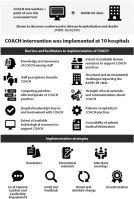心力衰竭治疗效果和可及性比较试验(COACH)的实施情况
IF 2.5
Q2 CARDIAC & CARDIOVASCULAR SYSTEMS
引用次数: 0
摘要
背景心力衰竭治疗效果和可及性比较(COACH)试验表明,使用护理点风险评估工具和快速门诊过渡性心力衰竭门诊可显著降低急性心力衰竭患者的死亡和心血管疾病住院率。我们报告了 COACH 干预和策略实施的过程评估。方法我们对员工进行了纵向访谈,以评估 COACH 实施的障碍和促进因素。根据理论领域框架(TDF)和实施研究综合框架(CFIR)对各种因素进行了编码。我们绘制了干预图,以确定以理论为基础的策略,从而消除障碍并影响实施的促进因素。我们利用访谈、文件审查和与实施团队的电话沟通来描述这些策略的采用情况以及随着时间的推移这些策略对实施成功的影响。我们发现了影响 COACH 实施的 10 个因素,分别与 6 个 TDF 和 5 个 CFIR 领域相对应。一些障碍在研究期间得到了解决,但其他障碍则长期存在。我们向教学点推荐了七种实施策略。参与者认为,充足的准备时间、特定场所的人员支持、有利于满足干预需求的结构和社会特征以及实施经验是促进成功实施的因素。我们建议希望实施 COACH 的医疗机构进行快速实施评估,并提出了可用于减少障碍和促进因素的策略,以提高实施的成功率。本文章由计算机程序翻译,如有差异,请以英文原文为准。

Implementation of the Comparison of Outcomes and Access to Care for Heart Failure (COACH) Trial
Background
The Comparison of Outcomes and Access to Care for Heart Failure (COACH) trial demonstrated that use of a point-of-care risk assessment tool and a rapid ambulatory transitional heart failure clinic led to significant reductions in death and cardiovascular hospitalisation among patients with acute heart failure. We report a process evaluation of COACH intervention and strategy implementation.
Methods
We conducted longitudinal interviews with staff to assess barriers and facilitators to COACH implementation. Factors were coded according to the Theoretical Domains Framework (TDF) and the Consolidated Framework for Implementation Research (CFIR). Intervention mapping was conducted to identify theory-rooted strategies to address barriers and influence facilitators toward implementation. We used interviews, document reviews, and check-in calls with implementation teams to describe uptake of these strategies and their impact on implementation success over time.
Results
A total of 29 interviews were conducted across 10 sites. We identified 10 factors that affected COACH implementation, which corresponded to 6 TDF and 5 CFIR domains. Some barriers were resolved within the study period, but others persisted over time. Seven implementation strategies were recommended to sites. Participants identified ample preparation time, site-specific personnel support, structural and social characteristics conducive to the intervention needs, and implementation experience as factors that facilitated implementation success.
Conclusions
We supported implementation of the COACH intervention in 10 acute care hospital sites and describe the factors impacting implementation. We recommend a rapid implementation assessment to sites wishing to implement COACH, and suggest strategies that can be used to mitigate barriers and aid facilitators to improve implementation success.
求助全文
通过发布文献求助,成功后即可免费获取论文全文。
去求助
来源期刊

CJC Open
Medicine-Cardiology and Cardiovascular Medicine
CiteScore
3.30
自引率
0.00%
发文量
143
审稿时长
60 days
 求助内容:
求助内容: 应助结果提醒方式:
应助结果提醒方式:


